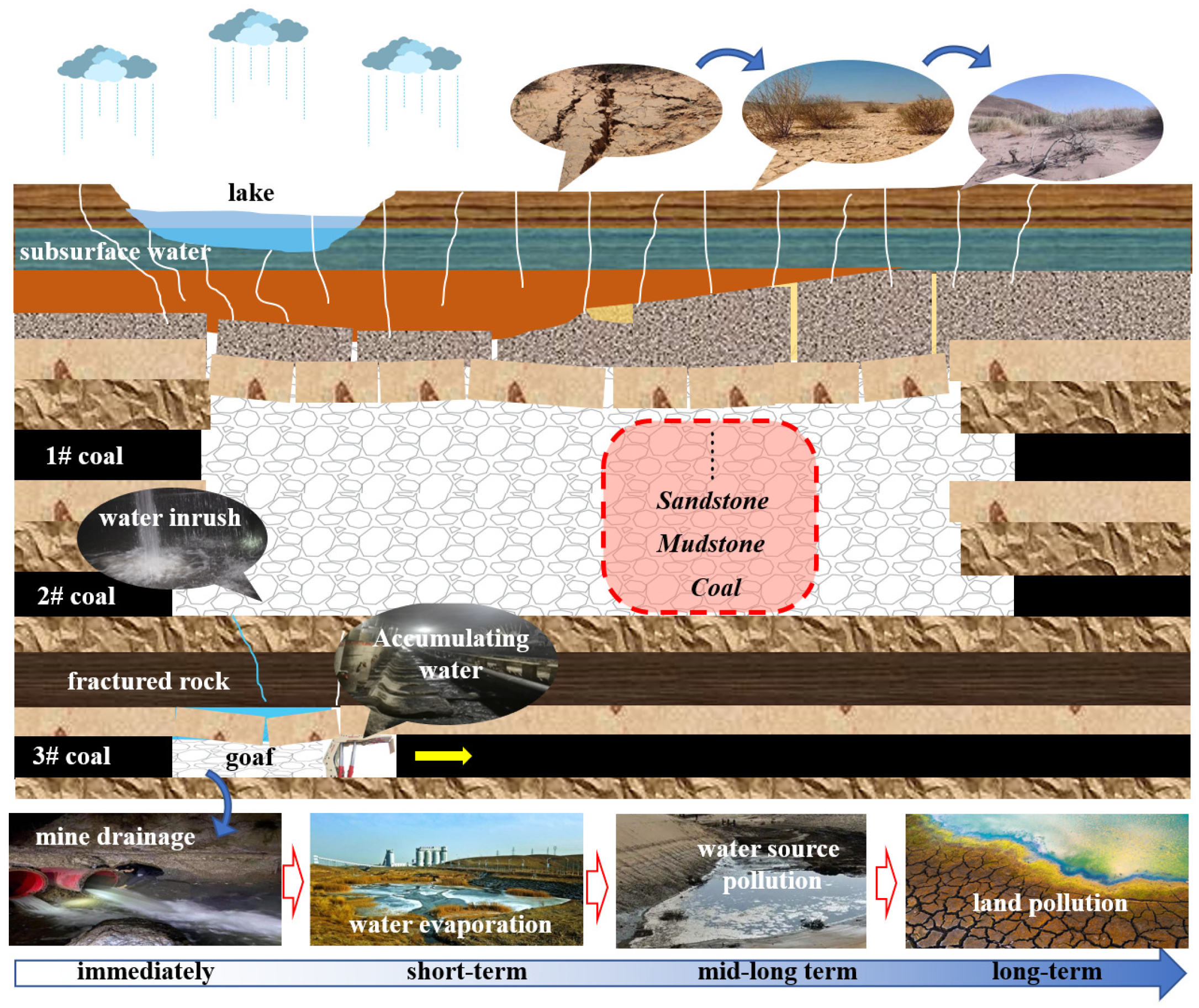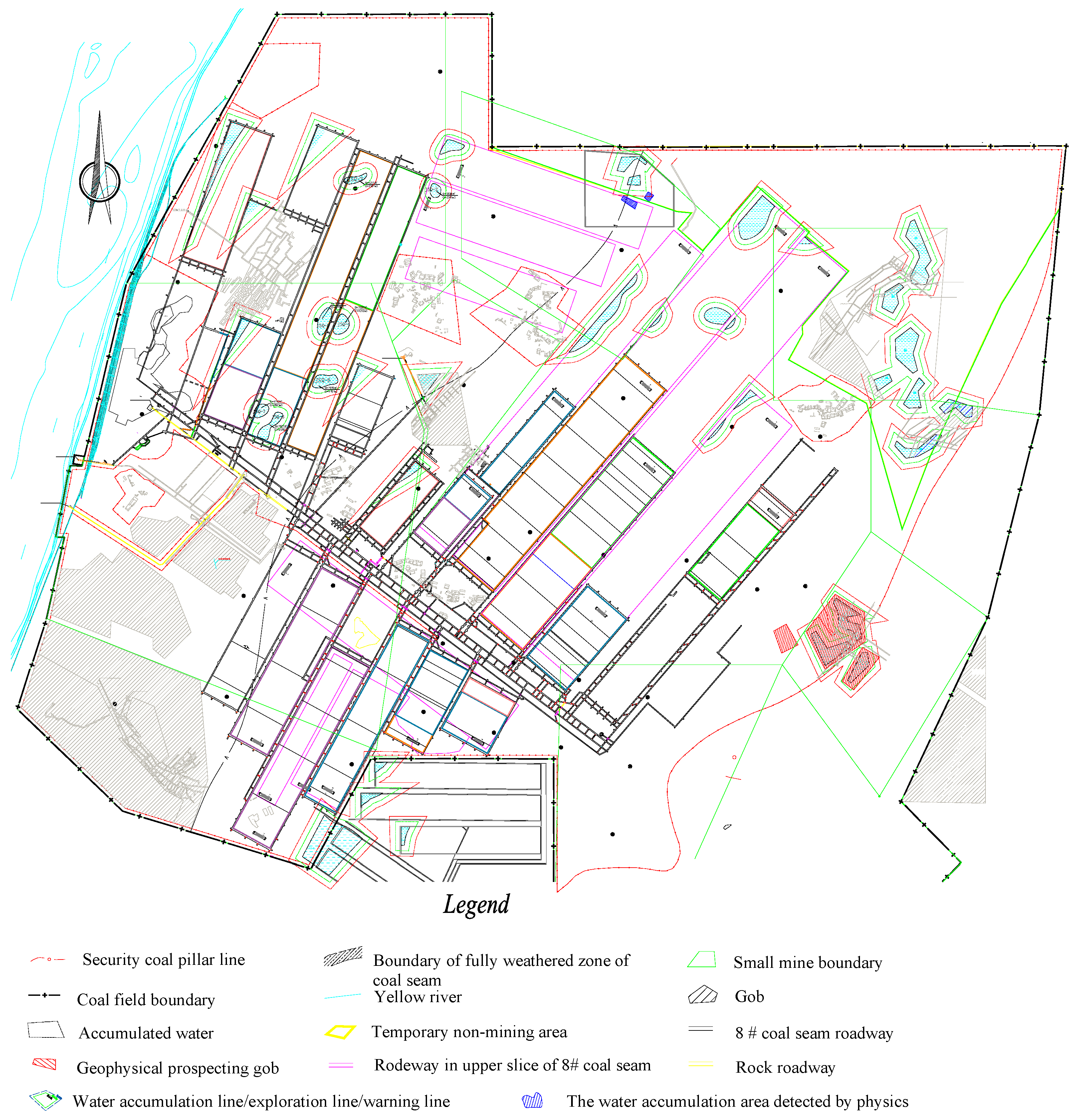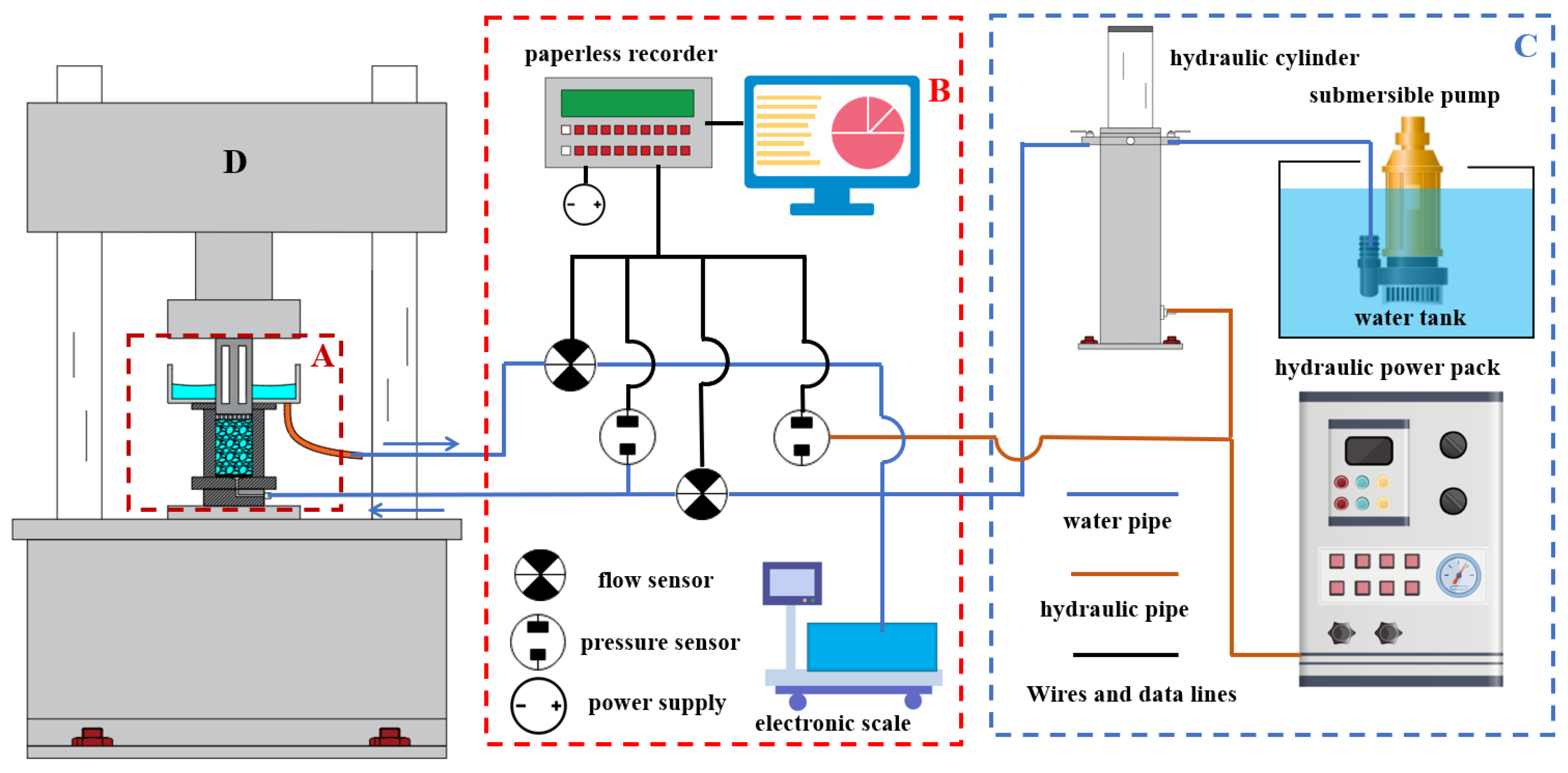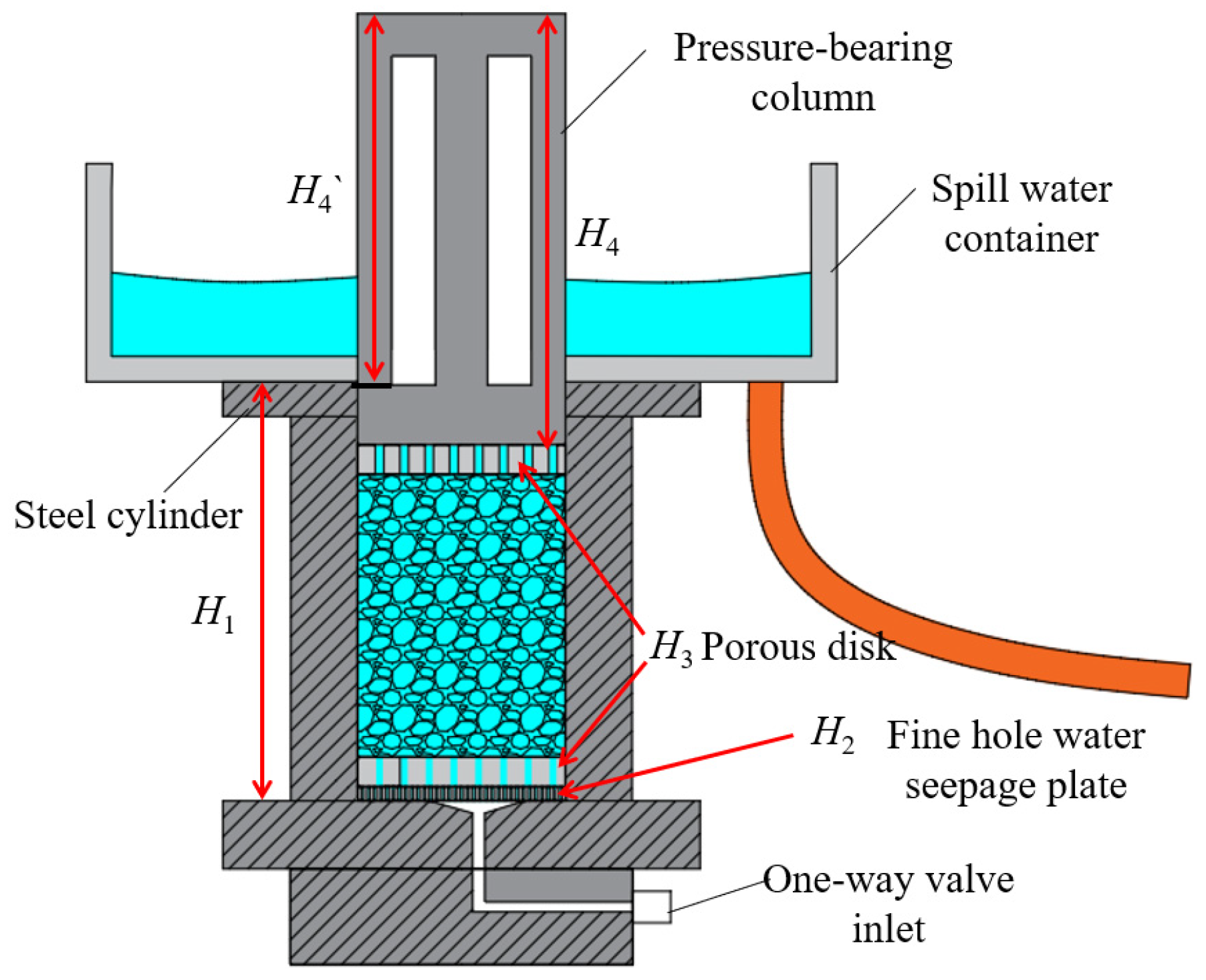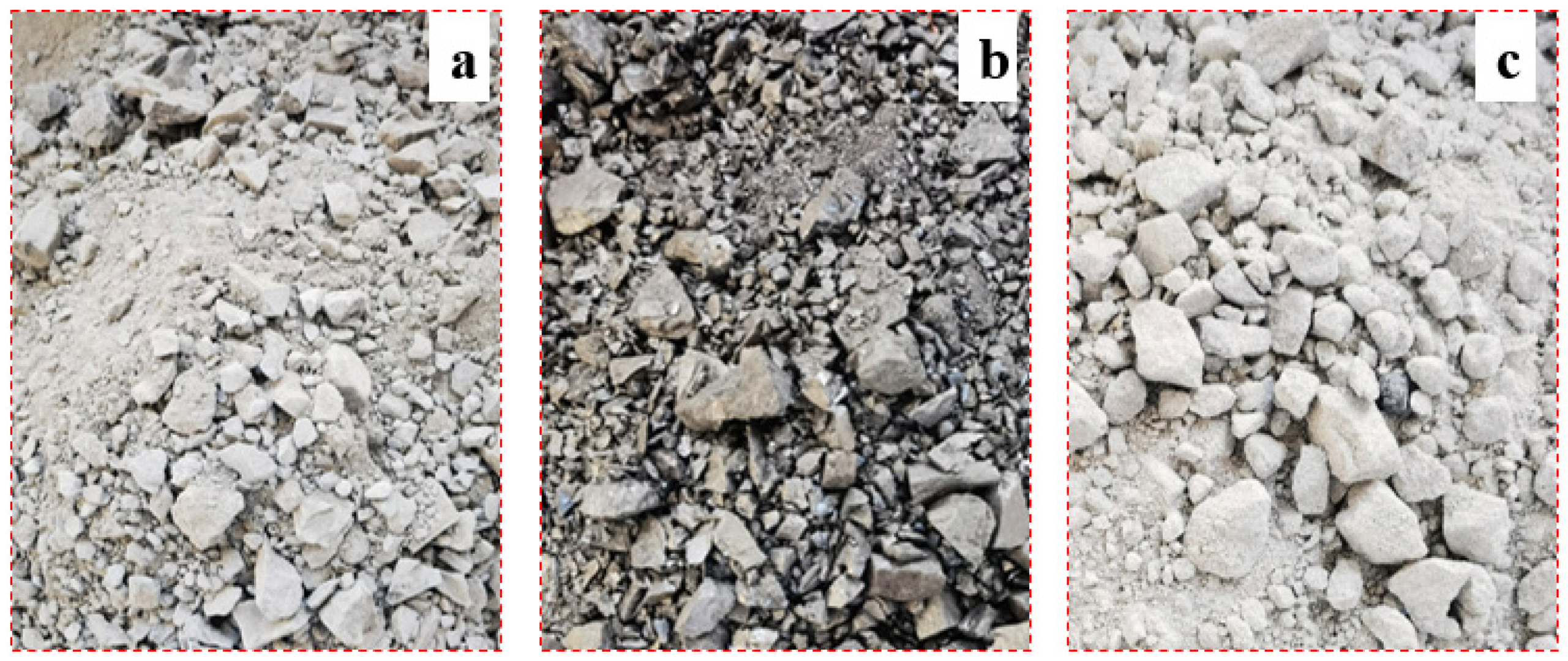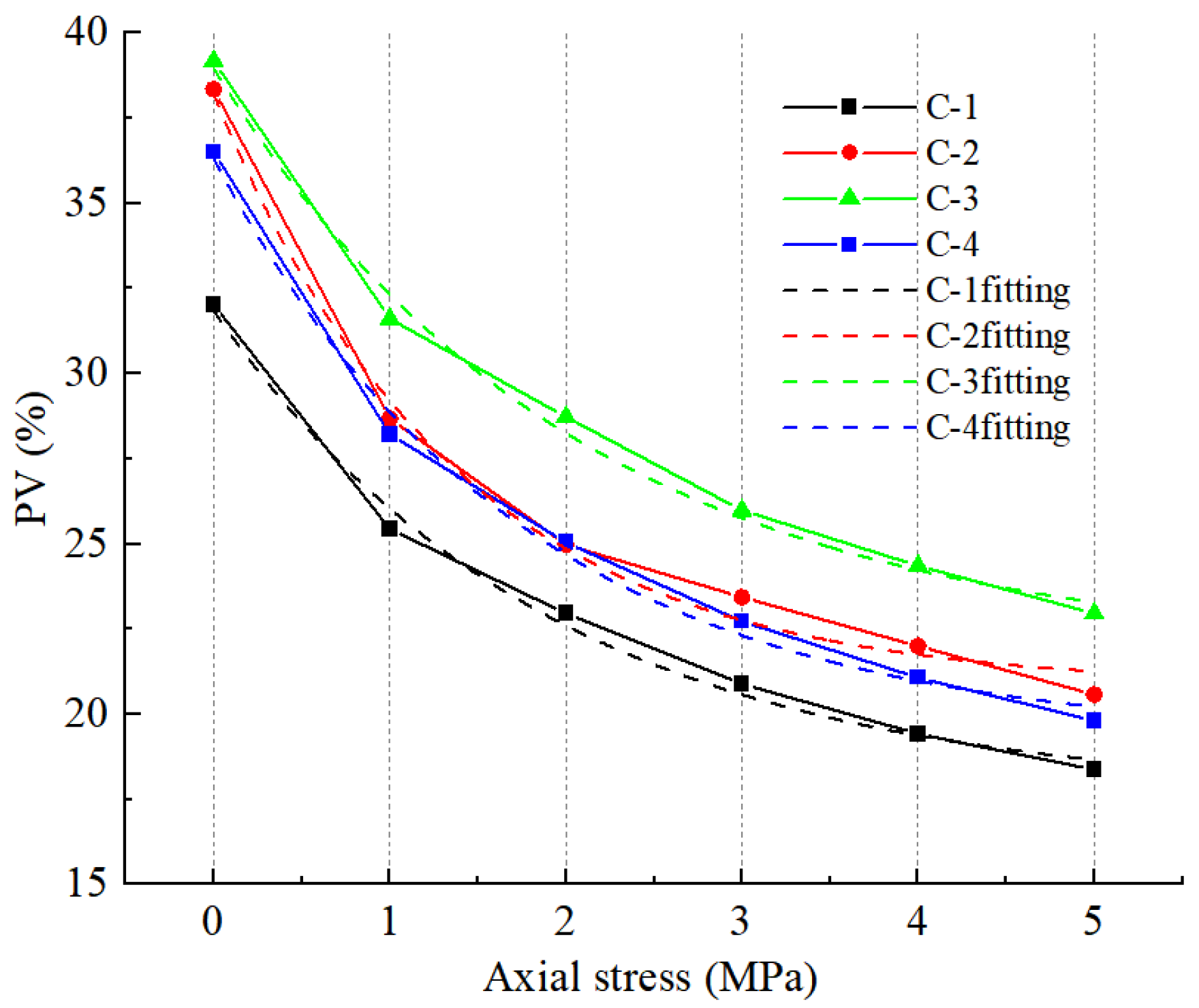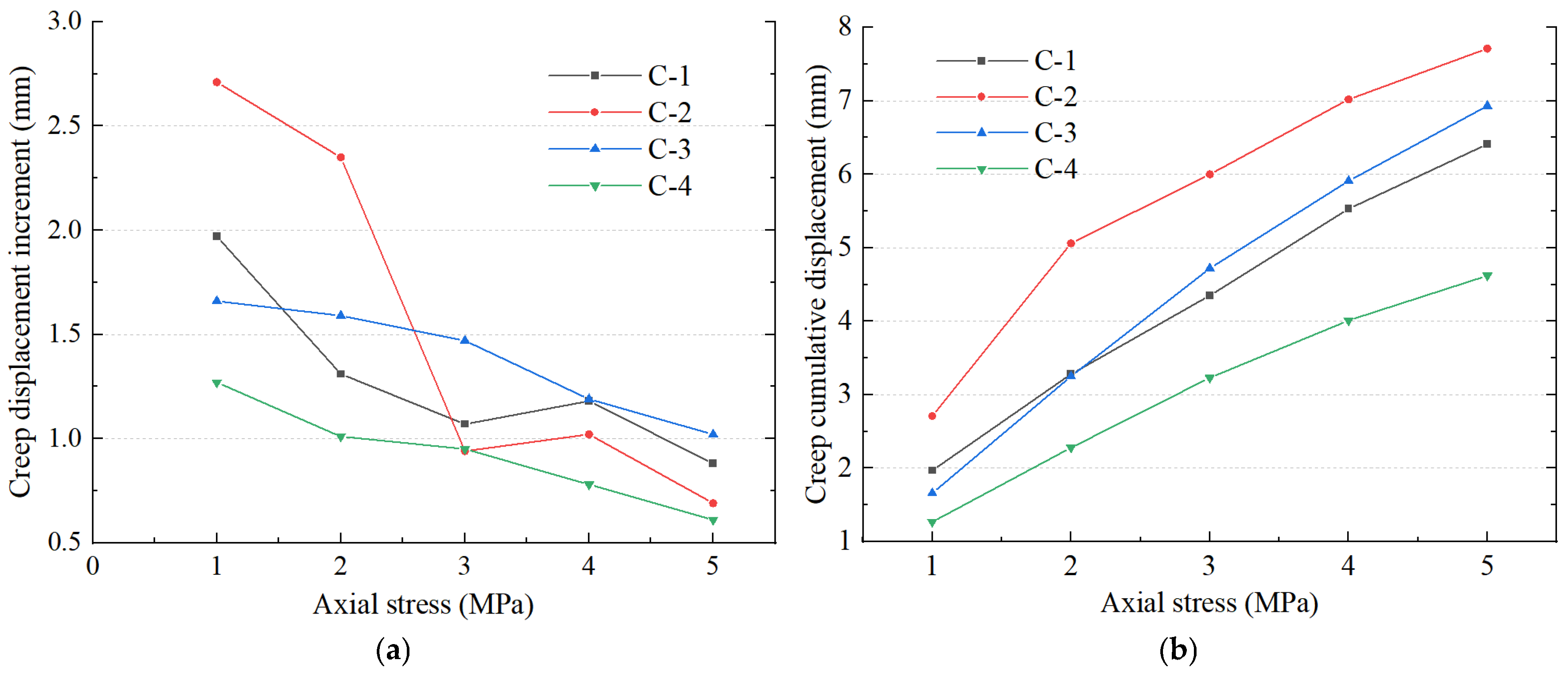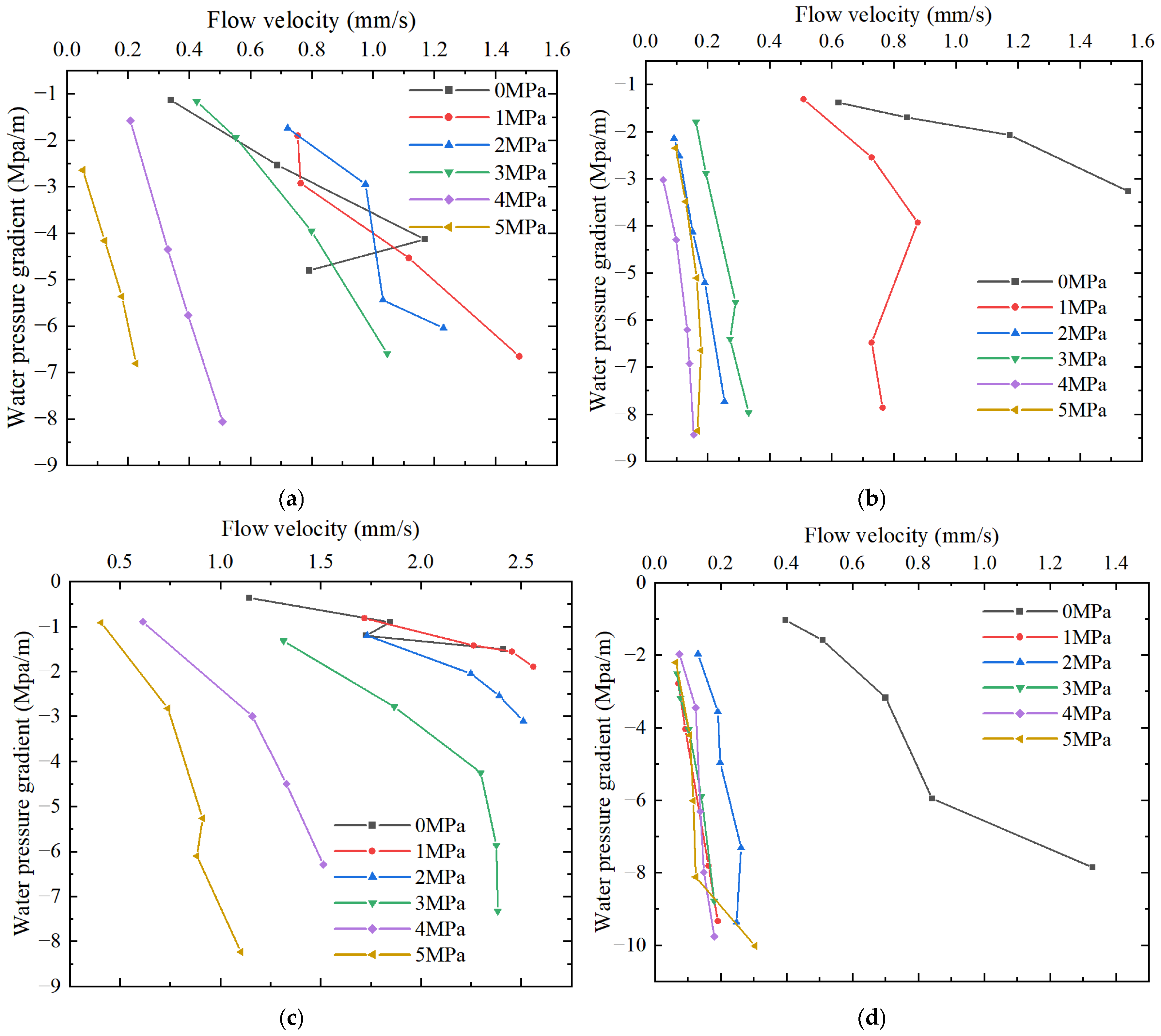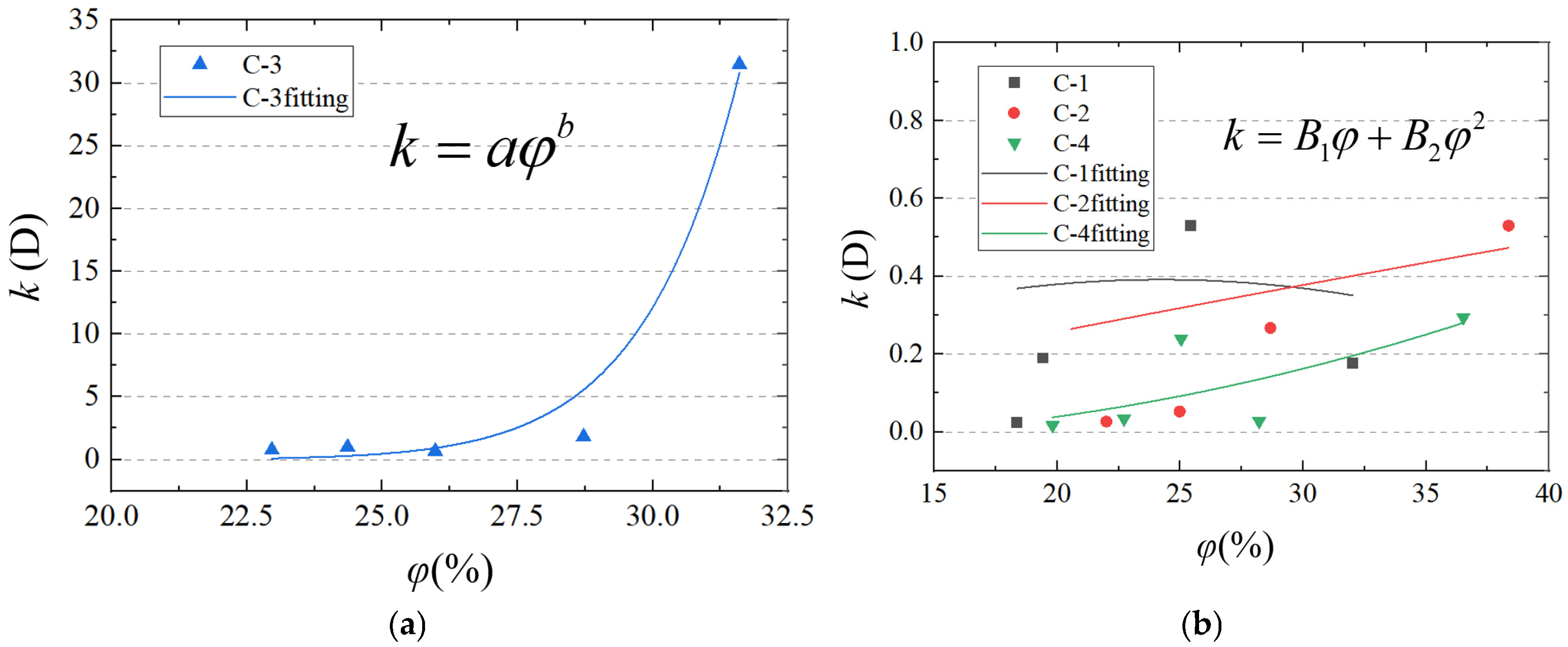1. Introduction
The mining of shallow coal seams severely disrupts groundwater equilibrium, adversely impacting the mining area’s ecology and increasing mine water inflow [
1,
2,
3,
4]. In China, coal resources and water resources exhibit an inverse spatial distribution. Due to policy-driven development, western regions have emerged as the primary coal-producing areas. As illustrated in
Figure 1, the typical geological characteristics of shallow buried coal seam groups include multi-seam intervals, argillaceous soft rock layers, and sandy hard rock structures [
5]. These regions face water scarcity and ecological fragility, exacerbated by high-intensity coal mining [
6,
7]. In 2023, the five major western coal bases accounted for over 80% of national coal production. The expansion of large-scale mining operations and soaring coal output have significantly increased goaf areas. After a mining fracture destroys the aquifer, groundwater migrates to the goaf [
8,
9,
10].
To prevent water inrush accidents, extensive groundwater drainage is implemented, leading to several critical issues (
Figure 2): (a) Declining ecological water levels cause vegetation degradation [
1,
11]; (b) Over recent decades, large volumes of discharged mine water have primarily evaporated, leaving behind heavy metals and solutes that contaminate both water and soil [
12]; (c) Current regulations prohibit mine water discharge due to water quality and balance concerns, while treatment costs remain prohibitively high [
13,
14]; (d) Concealed water sources, when connected by mining-induced fractures, often trigger large-scale casualties [
15]. Aquifers are particularly vulnerable to mining-induced fractures following shallow coal seam extraction [
16,
17]. The seepage characteristics of compacted broken rock in goaf areas are crucial for evaluating the permeability of repeatedly mined overburden, which is essential for ensuring mining safety.
Numerous compaction–seepage experiments on broken rock have significantly enhanced our understanding of nonlinear seepage behavior. By integrating mechanical testing systems with water pressure control systems, researchers can analyze the seepage characteristics of broken rock under various compaction conditions. The displacement control method proves effective for establishing theoretical models of broken rock compaction–seepage under different compaction levels, while the load control method is more suitable for investigating compaction–seepage characteristics (CSCs) under specific engineering conditions [
18]. Current research has examined CSCs related to lithology, particle size, and mixed-particle-size samples, with particular attention to complex phenomena such as particle migration, erosion of weakly cemented minerals, and water–rock mixed flow [
19,
20,
21,
22]. However, in underground coal mining engineering, the roof—as a critical surrounding rock zone—typically consists of multiple lithological combinations. While studies have established CSCs for single lithology samples, research on the CSCs of combined lithologies in goaf areas remains relatively limited.
The hardness, lithology, and structural composition of roof strata are fundamentally linked to key strata control elements, including mine pressure manifestation, bolt support design, non-pillar mining techniques, and coal pillar width determination [
23,
24,
25]. These geological parameters, along with roof structure characteristics and the thickness ratio between bedrock and overburden layers, serve as critical criteria for water resource protection zoning in mining areas [
26].
Coal measure strata can be classified into three primary types based on mineral composition and mechanical properties, mudstone, sandstone, and coal seams, each exhibiting distinct functional behaviors during mining operations [
27,
28]. In the Ordos Basin, where coal seams predominantly originate from fluvial-lacustrine deposits, mudstone typically interbeds with coal layers [
29]. The naturally low permeability of mudstone makes it an effective aquiclude. Within goaf areas, roof strata typically comprise multiple layers including immediate roofs and false roofs in the caving zone, while sandstone generally forms structural layers that function as main roofs and key strata, governing periodic mine pressure behavior [
30,
31].
Coal seams primarily serve as mining targets but may also occur as immediate or false roofs that collapse into the goaf during the working face advancing. Importantly, roof structure significantly influences the permeability evolution characteristics of compacted broken rock in goaf areas [
32,
33,
34]. While single-lithology studies indicate that fractured mudstone in shallow coal-bearing strata shows the greatest potential for waterproof recovery [
18], actual caving zones in shallow coal seam goafs typically contain vertically mixed lithological combinations (
Figure 2). This complex arrangement necessitates focused research on the seepage characteristics of compacted broken roof materials with combined lithologies.
This study investigates the water-resisting recovery characteristics of compacted lithological combinations in broken roof strata within shallow coal seam goafs. Using Shaping Coal Mine as a representative case study of typical shallow coal seam groups, we conducted experiments to analyze the compaction–seepage characteristics (CSCs) of lithologically combined broken rocks under shallow buried stress conditions. The Forchheimer theory was employed to model the seepage behavior of compacted broken rock. To quantify water-resisting capacity recovery, we introduced a void sensitivity index for characterizing permeability evolution during rock compaction. Based on experimental results, we developed a comprehensive permeability analysis model for combined lithology broken rock in shallow goafs. Furthermore, this study establishes a compaction-permeability analytical model specifically for caved rock strata in shallow mining conditions.
2. Engineering Background
Shaping Coal Mine of Shanxi Jinshen Energy Co., Ltd. is located in Hequ County, Shanxi Province, China. The approved production capacity of the mine is 8.00 Mt/a. The mining area borders the Yellow River and represents typical shallow coal seam group mining conditions. As a model integrated resource mine, Shaping Coal Mine extracts coal seams 8 #~13 #, with overlying goafs of varying configurations—predominantly room-and-pillar and longwall mining systems. These upper goafs, containing significant water accumulation, pose potential hazards such as concealed water bodies that may impact safe and efficient extraction of underlying coal seams.
Figure 3 illustrates the spatial distribution of these upper goafs and their water accumulation characteristics.
In arid mining regions, water resource conservation and roof water management during downward coal seam group extraction have emerged as critical challenges for achieving sustainable and safe mining operations. Current high-intensity longwall mining practices inevitably lead to water resource depletion during extraction. Nevertheless, the restoration of water-resisting capacity through goaf compaction in the caving zone fundamentally determines the extent of roof water drainage required.
The roof structure of Shaping Coal Mine is shown in
Table 1. Following collapse and subsequent compaction in the goaf, the roof strata undergo secondary fragmentation, exhibiting distinct grading characteristics [
18]. Furthermore, according to the structural characteristics of the roof, there are different types of broken rock combinations in the goaf.
This study investigates the CSCs of typical lithological combinations in shallow coal seam goafs. Rock samples were prepared to simulate shallow coal seam conditions, with loading stages designed based on the self-weight stress environment characteristic of shallow goafs. Using lithological combination as the primary control variable, we conducted systematic experiments to measure permeability evolution in composite broken rock samples under varying compaction states. This research aims to elucidate how roof lithology combinations influence the restoration of water-resisting capacity in shallow coal seam goafs.
4. Results
4.1. Characteristics of Voids
Using crushed rock samples with a consistent porosity (
η) of 0.5, we systematically analyzed the void characteristics and bulking behavior across different lithological combination layers (
Table 4). The results reveal that mudstone and sandstone exhibit comparable pore volumes (PV), with average values of 33% (PV) and 1.50 (bulking coefficient). In contrast, coal samples demonstrated significantly higher porosity, showing an average PV of 43% and bulking coefficient of 1.76.
4.2. Compaction Characteristics
In the compaction seepage experiment of lithological combination samples, the axial stress was 0–5 MPa, and 1 MPa was used as the graded loading gradient to test the seepage characteristics under 0 MPa, 1 MPa, 2 MPa, 3 MPa, 4 MPa, and 5 MPa axial stress. The ‘stress-displacement’ and ‘stress-strain’ recorded during the whole compaction seepage experiment are shown in
Figure 7. The results show that the axial compression of 2 MPa is the dividing line. When the axial compression is less than 2 MPa, the order of strain from large to small under the same axial compression is C-2 > C-4 > C-3 > C-1. When the axial compression is greater than 2 MPa, the order of strain from large to small under the same axial compression is C-2 > C-4 ≈ C-3 > C-1. In the C-1 case, the stress decreased and then increased. The compaction curves of C-4 and C-3 are close to the same compaction characteristics after 2 MPa axial compression. Creep phenomenon is common under five-stage axial compression in the range of 1~5 MPa. The seepage water pressure of the C-3 has the least influence on the pulse of the load under constant load.
According to the results, the seepage and compaction characteristics of the combined crushed stone have the following characteristics: the strain of the combined crushed stone within 0~2 MPa axial compression is affected by many factors such as lithological strength, softening characteristics, layered thickness, number of interfaces, accumulation structure, and initial PV. Therefore, the ‘mudstone-coal’ combination condition has the largest deformation during the initial compaction process. From a comprehensive perspective, the compaction characteristics are still dominated by the initial PV, and the order of strain and initial PV in the compacted state is finally consistent. In a non-argillaceous rock combination sample of ‘coal-sandstone’, the contribution rate of seepage water pressure to the external load of broken rock is small.
The void and bulking characteristics of each sample under different axial stresses are shown in
Figure 8. The compaction characteristic parameters of the four composite samples fitted by Formula (2) are shown in
Table 5.
The creep amount of the load-holding stage during the compaction process is shown in
Figure 9. From
Figure 9a, it can be seen that the overall regularity of the change in creep amount in the same period under fixed axial stress is poor. For C-3 and C-4, the change trend of creep under each axial stress is similar. Combined with the above-mentioned stress–strain law, the compaction characteristics of C-3 and C-4 are similar as a whole. The creep amount of C-2 is greater than that of C-1 in the range of no more than 3 MPa axial compression. After the axial compression is greater than 3 MPa, the creep amount of C-1 and C-2 has the same trend, and the creep amount of C-1 is greater than that of C-2. However, the overall regularity of creep accumulation under each axial stress is good. As shown in
Figure 9b, the creep accumulation is sorted into two sections from large to small. No more than 2 MPa: C-2 > C-1 > C-3 > C-4; more than 2 MPa: C-2 > C-3 > C-1 > C-4.
The results show that the corresponding lithology combination compaction process has the following characteristics: The addition of thin mudstone in the middle of the sandstone + coal combination condition has little effect on its compaction characteristics. About the 0~3 MPa axial compression range gives priority to crushed coal compaction, while the 3~5 MPa axial compression range is of mudstone-dominant creep characteristics. The creep amount of the combined compaction process of low-strength coal and mudstone broken rock is the largest.
4.3. Seepage Characteristics
Compaction seepage experiments were carried out on four samples with different lithological combinations. The seepage characteristics under different axial stress are shown in
Figure 10.
The results show that the seepage characteristics of C-1 change from unstable to stable in the range of 2–3 MPa. Subsequently, for the convenience of narration, the axial compression interval in which the seepage characteristics change from unstable to stable is called seepage stabilized axial compression (SSAC). In the axial compression range of 3~5 MPa, the permeability decreases by one order of magnitude for each 1 MPa increase, the flow rate decreases sharply, and the nonlinear seepage characteristics are stable. The SSAC of C-2 is 1~2 MPa, and the flow velocity decreases sharply under the axial stress of 1 MPa, and then the decrease of flow velocity becomes smaller. The SSAC of C-3 is 0~1 MPa. In the axial compression range of 3~5 MPa, the flow velocity decreases obviously with the increase of 1 MPa, and the flow velocity tends to be stable with the increase in water pressure gradient. The flow velocity of C-4 decreased sharply after axial compression loading. With the gradual compaction, the flow velocity changed little and fluctuated in a small range. In the case of various lithological combinations, the flow velocity of sandstone and coal composite specimens under the same axial stress is the largest. The remaining samples have mudstone combinations, and the variation range of flow velocity is close.
The permeability and non-Darcy factor are obtained by fitting, and then the changes in
k and
β under different
φd are analyzed as shown in
Table 6. The results of compaction–seepage process show that: For C-1,
φd is decreased by 13.65%,
k increases first and then decreases, and the absolute value of
β increases monotonously. For C-2,
φd decreased by 17.78% during the compaction and seepage process,
k experienced two ‘decrease-increase’ fluctuations, and the absolute value of
β increases monotonously. For C-3,
φd decreases by 16.21%,
k has two ‘increase-decrease’ fluctuation changes, and the absolute value of
β increases monotonously. For C-4,
φd decreased by 16.70%,
k had three ‘decrease-increase’ fluctuations, and
β had two ‘increase-decrease’ fluctuations.
The experimental results show that the seepage characteristics of the combined rock samples under low axial stress are unstable, and the curves of water pressure gradient and flow velocity show tortuous characteristics. The flow velocity of the combined samples with mudstone is small, and the flow velocity does not exceed 1.6 mm/s. The flow velocity of the combined samples without mudstone is larger, and the flow velocity exceeds 2.5 mm/s. Under the same axial stress and water pressure gradient, the flow velocity of mudstone can be reduced by about 36%. The change trend and change times of CSC of lithology combination are related to the order and number of interfaces of lithology combination.
5. Discussions
This paper analyzes the lithological combination characteristics in shallow buried goaf areas. Step-loading and steady-state seepage experiments were conducted to investigate the seepage behavior under different compaction states. The variations in compaction stress, porosity, and permeability were determined. Furthermore, the correlation between the experimental findings and the engineering conditions of shallow coal seam group mining requires further discussion.
5.1. Sample Characteristics After Compaction Seepage
After the test, the sample experiencing compaction seepage was extruded from the seepage device (see
Figure 11). By observing the characteristics of the samples, it is found that the ‘sandstone + mudstone’ combination sample is divided into two sections of cementation. The cementation at the interface is poor, and separation occurs after extrusion. The graded sandstone is broken obviously, and the coarse pore permeable plate is filled. The surface of the graded mudstone is compacted and broken, and the sandstone particles are distributed between the broken rock, indicating that the sandstone is broken and migrated to the mudstone layer with the water flow.
On the whole, the combined samples with coal are not cemented, and the particle migration occurs in the compaction and seepage process of graded mudstone and sandstone, which is blocked in the sample in front of the seepage path. Based on this, it is speculated that re-crushing mainly occurs in broken coal seams during compaction. The reasons include the low strength of coal samples, softening in water, and sharp broken particles, which are prone to stress concentration. The migration of particles blocking the seepage section is an important reason for the decrease in permeability. Water–sand mixed flow and mud migration are typical seepage erosion phenomena, and the permeability decreases during the migration across the interface. In the corresponding engineering site, the permeability reduction at the interface of the broken rock combination can promote the formation of a stable relatively impermeable layer in the goaf. An important reason for the permeability instability caused by re-mining is that the interface of the broken rock combination is destroyed again. Mud and fine sand migrate with groundwater, and water inrush, sand inrush, and mud inrush occur in the mining space. Due to the influence of lithologic combination, the management process of coal seam goaf needs to focus on the water accumulation in goaf, the compaction permeability of broken coal and rock, and the conduction state of interlayer strata during repeated mining. It is a necessary measure to drain the water in the goaf of the roof before mining, and the permeability evaluation after repeated mining is of great significance for the storage and migration of groundwater.
5.2. Permeability Analysis Model
To obtain the
φ-
k relationship of the broken rock compaction process, the
φ-
k curve is fitted. According to the characteristics of the experimental data, the combined samples without mudstone are fitted by exponential fitting and the combined samples with mudstone are fitted by a quadratic function. The fitting curve is shown in
Figure 12, and the parameter results are shown in
Table 7.
The compaction characteristics of broken rock have been obtained in
Section 4.2. Combining Formula (2) and the
φ-
k model in
Figure 12, respectively, the
σ-
φ-
k analysis model of the compaction process of lithologic combination broken rock can be obtained in Formulas (3) and (4).
It should be noted that the fitting degree of the φ-k relationship of the combined samples containing mudstone is low and there is volatility. In the case of overburden permeability assessment serving water inrush prevention, it is necessary to consider the discreteness and increase the safety factor.
5.3. PV Sensitivity of Permeability
The permeability of the collapsed rock mass is mainly determined by the voids and the void structure. The low porosity of the mudstone layer in the lithology combination sample is the main reason for the low permeability of the combination sample. To analyze the permeability variation characteristics of compacted rock mass, the PV sensitivity parameter of permeability change (
Dg) is adopted.
where
ks is initial permeability,
ke is compacted permeabilities,
φs is initial PV, and
φe is compacted PV.
In
Table 8, the
Dg of the combined samples is not more than 20. The
Dg of the sample containing mudstone combination is significantly smaller than that of the C-3. The
φs and
φe of the C-3 samples are the largest. In addition, the combination of sandstone and coal lacks the plugging effect of mud, which together leads to the C-3 exhibiting significantly higher
Dg values compared to other samples.
The low ks and Dg jointly indicate that the mudstone and sandstone combination has the best water-proof recovery ability, followed by the sandstone + mudstone + coal combination and the mudstone + coal. To reduce the loss of water resources in overlying strata and eliminate the risk of water inrush in lower coal seam mining, the caving coal seam in goaf should be reinforced and anti-seepage treated to ensure that the goaf of overlying strata has a water-proof function. The value of ks indicates that the permeability of the combined samples containing mudstone is significantly lower under the uncompacted state, and ks is related to φs, showing a consistent order of magnitude. The combination of different lithology shows that, under the condition of compacted, that is, under the condition of self-weight stress recovery, the permeability of the combined samples containing mudstone is similar and the water resistance performance is better. The permeability and porosity of the composite samples containing coal are larger. Therefore, the existence of residual coal in goaf is not conducive to the recovery of compaction and water insulation performance in goaf.
The results of
Figure 7 and
Figure 8 show that one of the important reasons for the fastest recovery of sandstone and mudstone combined compaction is that the initial porosity of the compaction process is the lowest and the porosity under different loading levels is always the smallest. The minimum
Dg of C-1 sample shows that the sandstone and mudstone combination sample has the characteristics of low permeability and small reduction in permeability during compaction.
5.4. Future Work
The migration of particulate matter and argillaceous material obstructs voids along the seepage path, leading to reduced permeability in the vertical composite unit. This phenomenon provides valuable insights for artificial aquifuge design. It is planned to enhance the erosion of upper broken rock in the goaf through environmental induction, such as temperature and PH, to realize the gap sealing of the lower broken rock and reduce the leakage of water resources after coal mining.
At engineering sites, the critical mudstone layer in the goaf is affected by mining. As the gradation of broken rock away from the roof gradually becomes larger, the CSC of mudstone with different gradations need to be further analyzed. In addition, the upper goaf in the mining process of coal seam group will experience mining influence many times, and the influence of caving and re-compaction on the permeability of broken rock in goaf needs to be explored.

